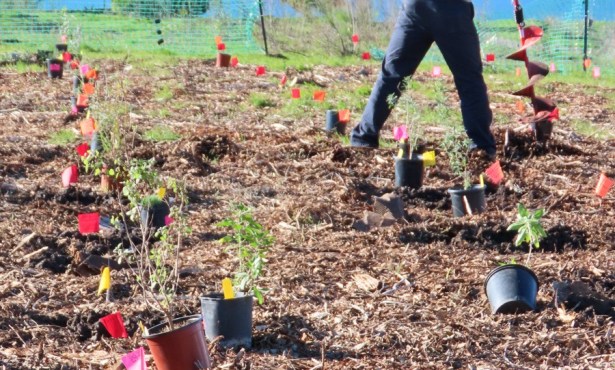Remembering the 2005 Storms
Trails Took a Major Hit During the January 2005 Winter Storms; This Year's Pattern Is Similar
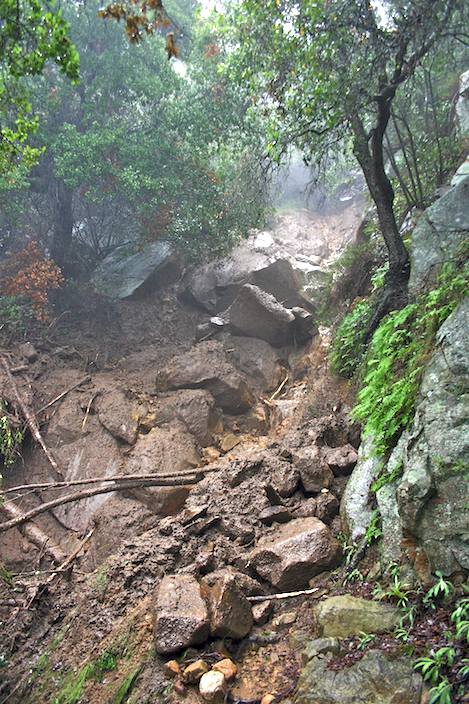
Author’s Note: This story appeared on The Indy Web site just over a year ago. Then, a series of early storms had hit the area, creating the potential for a similar amount of flood damage as occurred in 2005 when it rained for a week in early January then was topped off by a night of huge rainfall. Though the storms didn’t materialize then, as I sit at my computer looking outside at the deluge that is coming down, with the worst still to come Wednesday and Thursday, it looks like we are in for major flood damage. I’ll be out and about every day to let you know what’s happening.
Weather forecasters call them hundred-year storms but it seems like one of them hits the Santa Barbara area every five years or so. The last big set of storms to pound us occurred in 2005, almost exactly three years ago, with the first rains beginning in late December and continuing into early January. The December rains were deceptively quiet storms, the rain gentle and steady, not too unlike what we’ve had this year thus far.
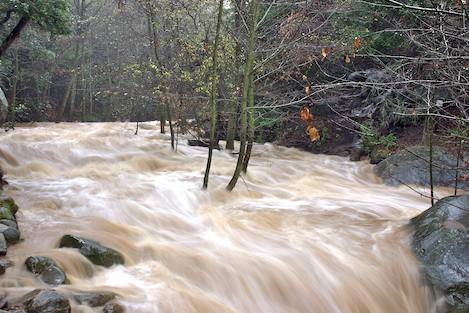
Then, in early January, when the Pineapple Express began to focus its storm track directly on us, the ground was thoroughly saturated and the creeks were already running at peak spring levels. There was no more room in the canyons for the water that began cascading down the hillsides, and the creek levels began to rise to higher and higher levels. By Sunday, January 9, 2005, every one of the front country creeks was flowing at flash flood stage.
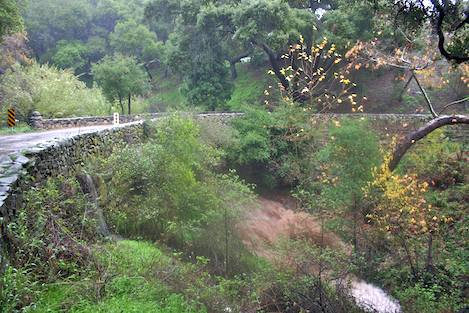
Along Las Canoas Road on the way up to Rattlesnake Canyon, the scenery was spectacular, every rivulet running, the hillsides a mist-filled green — the quiet before the deluge. Rattlesnake Creek itself was filling rapidly even though the rain was no more than a light drizzle.

I grabbed a stick and stuck it at the water’s edge and within minutes it was covered. The creek level under the stone bridge was rising somewhat alarmingly, and I worried that some of the wood that was being pushed down the creek might clog up under it and create a major mess. Up the trail, the waterfall at the old Mission Dam was roaring and at the first creek crossing the water was higher than I’d ever seen it, a brownish white combination of mud and foam. I decided not to go further. Later I discovered than another hiker had drowned while trying to cross the creek near here.
On to Cold Spring Canyon
I headed back down to my car and followed Mountain Drive east to the Cold Spring trailhead. There I discovered the creek crossing was not only impassable but the water was flowing so fast that getting trapped in it meant certain death. I detoured back down to Highway 192 and then up Hot Springs Road to work my way around to the other side of the Cold Spring crossing. By this time, the water crossing the road was close to five-feet deep.
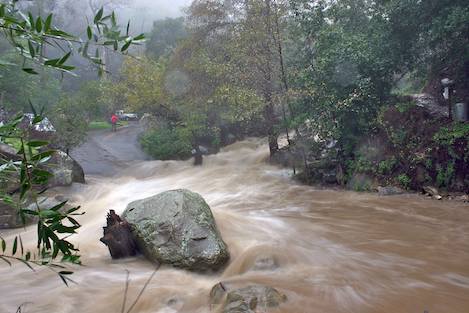
As I started up the canyon trail, the water was deep enough there and close enough to the trail to make getting by somewhat perilous. The water had also started to undercut the first set of steps just a few yards up the trail. I headed up to the bench that marks the intersection of the canyon and West Fork trails. The water was pounding but here the canyon was wide enough that I could stand back and enjoy the sounds and the feeling of the water’s power as it rushed downstream. After a few minutes the rain began in earnest and I scrambled back down the trail.
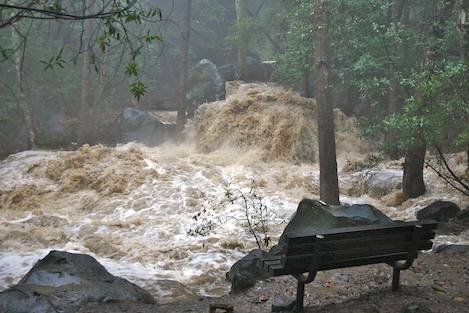
Little did I know how much damage that night’s rain would cause.
Rain damage is not so much a function of total amount but inches per hour. By Sunday night in Cold Spring Canyon, there had been enough rain over the past three weeks to last a season, yet it kept raining. At times the amount exceeded an inch-and-a-half an hour and it continued for almost seven straight hours. Saturated far beyond its carrying capacity, the hillsides began to collapse. In the West Fork Canyon the slides were huge, several carrying whole hillsides hundreds of feet into the canyon below. Fifteen-foot-tall ceanothus had slid downhill along with the mud and rock, blocking the trail and making it impassable. Along the main canyon trail, a number of the side creeks began to erode away, and three-, four-, and five-foot boulders caromed downhill, clogging sections of the trail with rock, brush, and trees.
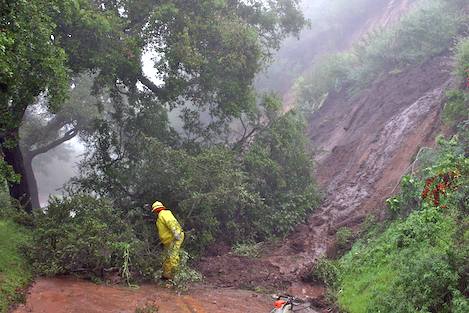
The next morning I headed up to Cold Spring Canyon just after 8 a.m. As I turned off Hot Springs Road and headed west on Mountain Drive the road was filled with mud and rock. A quarter mile from Cold Springs Trail the hill had collapsed and an oak partially blocked the road. Then a few hundred yards farther up a much larger oak lay completely across the road. I parked and continued on foot, wondering what it would be like ahead. I spotted a friend, Dan Gira, coming down from the canyon. He was soaked, mud covering his legs to the knees. When I asked him what it was like, he just smiled and said, “You’ve got to see it for yourself.”
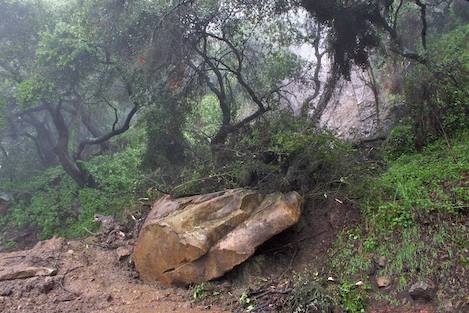
As I neared the trailhead I had a sense that everything was off kilter. I’d only been here 12 hours earlier yet I didn’t feel like I was in the same place. To my right a van-size rock at least 15 feet long lay at the side of the road. On the uphill side of the huge boulder I could see a massive slide that continued at least two hundred feet uphill.
As I reached the creek crossing I was amazed — the water not only covered the road but was so deep that it was close to cresting the high point on Mountain Drive and threatening to head east straight down the road. I waded through the water to reach the canyon trail and began to head up it. Fifteen yards up the trail I discovered the first of the big slides. The mud was knee deep and mucky with large rocks blocking the trail. A hundred yards up where the first small side creek crosses the trail the night’s flash flooding had carved a 10-foot-deep ravine and cut off the upper trail. I scrambled down into the side canyon then up the far side so I could continue on.
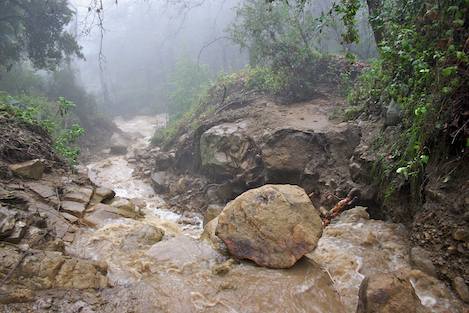
At the bench where I’d stopped yesterday, the water lapped against the bottom of it. The twin waterfalls across the canyon that make this spot such a perfect place to stop were completely covered with water. Incredible! As I meandered farther up canyon, the damage continued with a number of the side channels so clogged with rock and brush that it was difficult to get by; in others, enough of the trail had washed away along a number of the steep sections to make the footing treacherous at best.
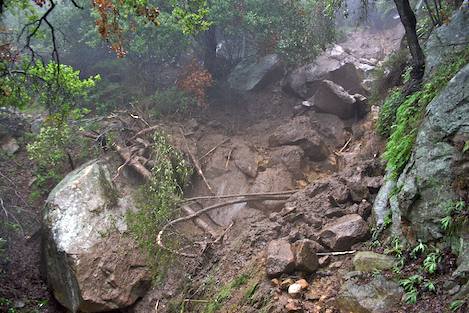
And the rain continued to fall.
That afternoon I contacted John Venable of Montecito Trails Foundation. MTF, as the group is known, has been active in maintaining trails in the 1st Supervisorial District of the county since 1964. I’d been doing much of MTF’s trail maintenance work for the past several years and wanted to let John know how bad the damage was. John quickly authorized the emergency repairs and over the next week our trail crew was able to eliminate the worst of the danger spots.
This past winter, working under a flood grant authorized by Los Padres National Forest, we were able to finish the repairs on the West Fork Trail as well as the Canyon Trail up to the power lines. But as the next storm heads our way, I’m wondering, are we in for the next hundred-year storm and will it be as damaging to the trails as the last one was?



